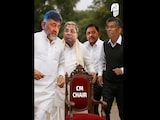American space agency NASA has released a playable version of space sounds. The project has been completed with the help of Sophie Kastner, a music composer, NASA said on its website. It also posted a photo of music notes created with the help of Ms Kastner, saying the data captured by its telescopes has become the basis of original music that humans can play. The data from the telescopes is converted into notes and sound by a process called sonification.
NASA has a repository of such sounds captured over the years, which have been posted on its website as a sonification playlist.
In the latest project, listeners will experience the data through the sense of hearing instead of seeing it as images, a more common way to present astronomical data.
"It's like a writing a fictional story that is largely based on real facts. We are taking the data from space that has been translated into sound and putting a new and human twist on it," Ms Kastner is quoted as saying by NASA.
The data used in the project is a compilation of sounds captured from a small region at the centre of our Milky Way galaxy where a supermassive black hole resides.
NASA got the data with the help of its Chandra X-ray Observatory, Hubble Space Telescope and now-retired Spitzer Space Telescope.
"We've been working with these data, taken in X-ray, visible, and infrared light, for years. Translating these data into sound was a big step, and now with Sophie we are again trying something completely new for us," said Kimberly Arcand, Chandra visualization and emerging technology scientist.
Ms Kastner said she chose to focus on small section of the image provided by NASA, as "small vignettes", so that it becomes more playable for people.
"In some ways, this is just another way for humans to interact with the night sky just as they have throughout recorded history," said Arcand. "We are using different tools but the concept of being inspired by the heavens to make art remains the same."
Sophie Kastner's musical piece is titled 'Where Parallel Lines Converge'. NASA has posted a link of the sonification on its website for other musicians to try it.















